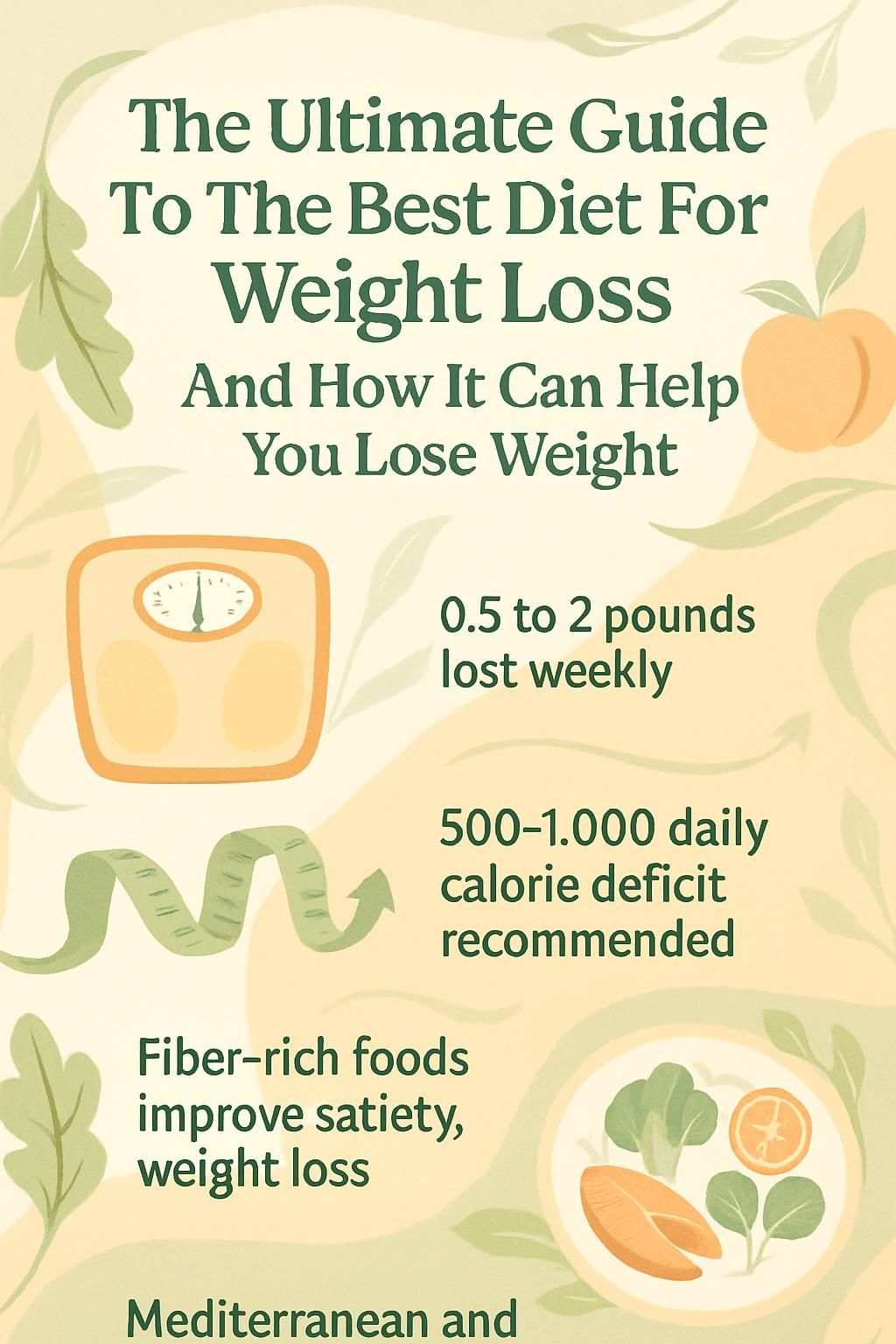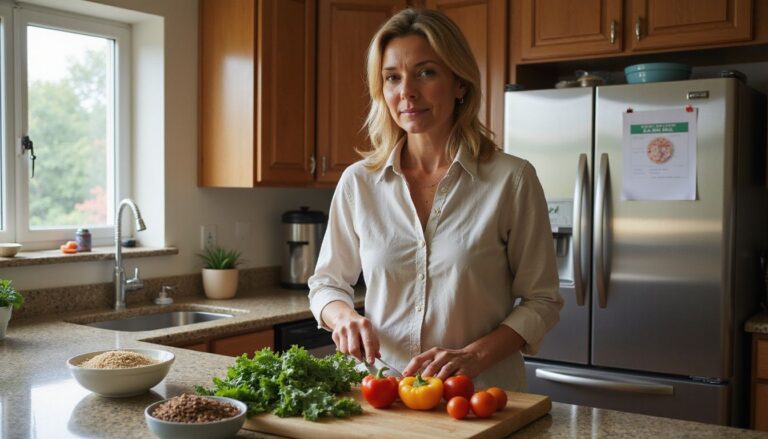The Ultimate Guide To The Best Diet For Weight Loss And How It Can Help You Lose Weight
Our Nutrition Assistant AI Suite will transform your body. You will lose fat, get toned, and build muscle. Gain confidence and optimal health.
Many people want weight loss that lasts, yet picking a diet can feel confusing. I have been there too, unsure where to start or which plan to trust. A simple path is to choose a healthy eating plan you can follow day after day.
Research shows most people can safely lose about half a pound to two pounds each week. I reviewed leading options like the Mediterranean diet and low-fat meal plans, then pulled out clear steps that work in real life. These ideas are easy to use and help build habits that stick.
Take control of your health by learning which foods support healthy weight and how a balanced diet creates steady change over time.
Key Takeaways
- Safe progress is about 0.5 to 2 pounds per week by creating a daily calorie gap of 500 to 1,000 calories.
- Eating plenty of fruits, vegetables, lean proteins, and whole grains lowers risk for heart disease, diabetes, and some cancers.
- Mediterranean and DASH patterns have strong evidence for weight management compared to fad or very restrictive low-carb plans.
- Regular exercise, at least 30 minutes on most days, plus a balanced diet supports fat loss and protects muscle.
- High fiber from leafy greens, legumes, nuts, and fibrous fruits helps you feel full and supports steady loss without feeling deprived.

Why Healthy Weight Loss Matters

Healthy weight loss lowers the risk of heart disease, type 2 diabetes, and some cancers. Reaching a weight that suits your body also brings more energy and better daily health.
Why is sustainable weight loss important?
Rapid weight loss often leads to quick regain once the diet ends, which many call yo-yo dieting. The best results come from slow, steady progress and lasting changes to eating, movement, and daily routines.
Clinical studies show people who lose weight gradually and follow a sustainable plan keep it off more often. I found fast-fix plans and very low-calorie diets made me hungry and tired. Focusing on whole grains, lean proteins, healthy fats, fruits, and vegetables helped me keep pounds off without feeling deprived.
“Quick fixes give quick returns, but lasting change requires consistency.”
What are the long-term health benefits of a healthy weight?
Keeping a healthy weight reduces the risk of type 2 diabetes, stroke, coronary artery disease, and some cancers like breast and colon. People who stay moderate in weight with a balanced diet and exercise often see better blood pressure and heart health across life.
Healthy routines lower belly fat and support steady energy balance, which eases strain on the heart and kidneys. Many trials link a healthy weight with less sleep apnea and lower odds of hypertension. The benefits reach beyond the scale, including higher energy, better sleep, stronger metabolism, and longer life expectancy.
Key Principles of a Successful Weight Loss Diet
A successful plan uses sound nutrition and creates a calorie deficit. I rely on balanced eating patterns that help me reach my goals and protect my health.
What is a calorie deficit and why does it matter?
A calorie deficit means eating fewer calories than your body uses. Health experts often suggest a daily deficit of 500 to 1,000 calories. That target supports a loss of about 1 to 2 pounds per week, which is a pace that protects muscle and avoids harsh side effects.
I tracked meals in an app to keep intake below what I burned. Even with fat-burning foods or regular workouts, the energy gap still matters most for long-term control. Very low-calorie diets under 800 calories need medical supervision, since most people require more nutrients for metabolism and overall health.
How do nutrient-dense foods aid weight loss?
Nutrient-dense foods pack vitamins, minerals, fiber, and protein without too many calories. A small amount of chia seeds mixed into yogurt increased fullness and reduced intake at the next meal in a clinical study. I add leafy greens like spinach and kale for fiber and thylakoids, plant compounds that may help control hunger.
Whole foods such as vegetables, fish, lean meats, fruits, nuts, seeds, legumes, and whole grains help me feel satisfied while keeping calories in check. Choosing these options also replaces sugary snacks and sweet drinks that work against progress.
How to balance macronutrients for best results?
A balanced mix of carbohydrates, protein, and fat supports weight loss and protects muscle. I use these steps as a simple guide.
- Set total calories based on age, activity, sex, and goals. Many adults do well around 1,500 to 2,000 calories for weight loss.
- Aim for 45 to 55 percent of calories from carbohydrates. Choose whole grains like brown rice and beans for better fullness and digestion.
- Get 25 to 30 percent of calories from lean protein. Options like chicken breast, fish, tofu, or legumes help preserve muscle during a deficit.
- Include 20 to 30 percent of calories from healthy fats. Focus on olive oil, avocado, nuts, seeds, and low-fat dairy to support heart health.
- Fill half your plate with vegetables, including leafy and cruciferous types, to boost fiber and lower calories.
- Limit added sugars and refined grains like white bread and candy, which spike blood sugar and often trigger hunger.
- Watch portion sizes with measuring tools or an app so even healthy foods do not push you over your target.
- Eat at regular times to support steady energy and digestion throughout the day.
- Adjust your macro mix if you have specific needs, such as diabetes, or follow patterns like Mediterranean or lower-carb plans.
- Work with a registered dietitian if you have medical conditions, are pregnant, or have digestive issues.
These steps made planning easier for me and helped me lose weight without feeling restricted.
Popular Diet Strategies for Weight Loss
Many people try different diet strategies. The most helpful patterns center on whole foods, steady habits, and long-term weight management.
What is the Mediterranean Diet?
The Mediterranean diet emphasizes fruits, vegetables, whole grains, fish, olive oil, nuts, and legumes. This traditional pattern from countries around the Mediterranean Sea supports weight control and long-term health.
I enjoy adding avocados to meals for healthy fats and heart support. Studies connect this pattern with lower breast cancer risk, better brain health, and improved weight management. It focuses on nutrient-dense foods instead of strict calorie counting, which helps me stay consistent.
Clinical research shows people on the Mediterranean diet may lose more body fat than those on fad or overly restrictive plans. The DASH diet offers another strong, flexible option.
How does the DASH Diet support weight loss?
The DASH diet highlights fruits, vegetables, whole grains, low-fat dairy, legumes, and lean proteins. These foods are high in fiber and protein but modest in calories, which helps reduce intake while meeting nutrient needs.
DASH also limits processed foods high in sugar, salt, trans fats, and refined grains. People who follow it often see weight loss and lower blood pressure within weeks. Experts view DASH as a balanced plan built for lasting change, not short-term tricks.
What are Low-Carb Diets like Keto or Atkins?
Low-carb plans, including Atkins, South Beach, and keto, restrict bread, grains, some fruits, and certain vegetables. They raise protein and fat while limiting carbs to as low as 20 to 50 grams per day in strict phases. Early weight loss can be quick, partly due to water loss.
Keto leads to ketosis, a state where the body uses fat for energy because carbs are very low. Some studies show short-term benefits, but the rules can feel narrow over time. Experts worry about missing fiber and vitamins when many grains and fruits are cut for long periods.
What are the benefits of Plant-Based Diets?
Plant-based diets limit or avoid animal products and center on fruits, vegetables, whole grains, nuts, and legumes. Studies link higher intake of beans and other plant foods with a lower risk of heart and metabolic problems.
These plans help many people keep a lower body weight. The meals are rich in fiber and lower in calories, which supports fullness. When I tried a vegetarian plan, soups with lentils and leafy greens kept me satisfied for hours compared to processed snacks.
Public health findings show that plant-forward choices often lead to better long-term results for people working toward a healthy weight.
How does Intermittent Fasting help with weight loss?
Intermittent fasting sets certain eating windows, such as 16:8 or 5:2, to create a calorie deficit without strict tracking. Endocrinology research shows these methods can help people eat fewer calories and lose weight.
People often report fewer cravings during fasting windows, though some find the schedule hard to maintain over time. Time-restricted eating felt easier to me than tracking every bite. Before starting fasting or any new routine, I check that the approach fits my health and daily life.
How to Choose the Right Diet for You
Choosing the best diet for weight loss starts with your needs and goals. I look for a plan that fits my schedule, taste, budget, and health status.
How to assess your lifestyle and preferences?
Knowing my routine and food likes helps me stick with a plan. I use this quick checklist.
- Check your daily schedule. Decide if you can prep meals or need quick options.
- Note which foods keep you full and satisfied.
- Consider how often you eat out, travel, or attend social events.
- Track hunger patterns. Decide if three meals, snacks, or fasting fits best.
- List any allergies or sensitivities like nuts, gluten, or dairy.
- Use tools like apps or reminders if accountability helps.
- Decide how plant-forward you want your plan to be.
- Review protein intake if past diets led to muscle loss.
- Choose a plan you enjoy. Enjoyment supports long-term adherence.
How to understand your health needs and goals?
After I consider daily habits, I look at my health needs. Safety and clarity help me build a plan that lasts.
- Schedule a visit with your clinician to review conditions, medicines, and concerns.
- Share past weight-loss attempts so your provider can guide you better.
- Consider bariatric surgery only after other methods and with a specialist referral.
- Ask if any diet you are considering needs medical oversight.
- Define your main reason for change, like energy or health risk reduction.
- Review family history that may shape your best approach.
- Match your preferences to evidence-based plans like Mediterranean or Nordic patterns.
- Set realistic goals, such as 1 to 2 pounds per week.
- Avoid fad plans that lack long-term safety data.
- Keep your personal health information private during all steps.
These actions help me make practical choices while protecting my health during every stage of weight loss planning.
When should you consult healthcare professionals?
I seek expert advice before starting strict or low-calorie diets. A registered dietitian can tailor guidance to my lifestyle and medical history. Children, teens, pregnant people, and older adults should only follow aggressive plans with professional support.
This content is for education only. It does not replace medical advice from your clinician.
Foods to Prioritize for Weight Loss
Focusing on specific foods can help you manage weight and feel your best. These choices give you more nutrition per calorie.
What leafy greens and cruciferous vegetables help?
Leafy greens like spinach, kale, and Swiss chard are rich in vitamins and minerals with very few calories. Their fiber and plant compounds may help increase fullness. I stay satisfied longer after a large salad or a side of steamed greens.
Cruciferous vegetables like broccoli, cauliflower, and cabbage also support weight loss. One cup of raw broccoli has about 31 calories and 2.4 grams of fiber. These foods add volume to meals so I feel full without many calories.
Which lean proteins are best for weight loss?
Lean proteins control hunger, protect muscle, and support a calorie deficit. Eggs make a simple breakfast that keeps me full. In one study, an egg breakfast increased fullness for several hours compared to cereal.
Chicken breast offers protein with little saturated fat when grilled or baked. Greek yogurt is high in protein and may lower risk for obesity or type 2 diabetes. These proteins help me stay on track through busy days.
How do whole grains and legumes support dieting?
Whole grains like oats, brown rice, and quinoa have more fiber and protein than refined grains. That means better fullness and fewer cravings. I felt the difference after swapping white bread for whole grain toast at breakfast.
Legumes such as lentils, black beans, and kidney beans deliver protein and fiber. Research shows fiber-rich diets with grains, seeds, and legumes can reduce body fat. Using these foods helps me meet nutrient needs while keeping calories in check.
What healthy fats should you include?
Healthy fats add flavor and help control appetite. Avocados provide monounsaturated fats, fiber, and potassium that support heart health. I add a few slices to salads or spread some on whole grain toast.
Nuts like almonds, walnuts, or pistachios bring unsaturated fats, protein, and fiber. A small daily handful supports heart health and appetite control. Studies show moderate nut intake does not cause weight gain for most adults because it boosts satiety.
Which low-calorie, high-fiber fruits are best?
After adding healthy fats, I look for fruits that offer fiber without many calories. Berries like raspberries, blackberries, and strawberries deliver the most fiber per calorie. Apples and pears with the skin on are portable and filling. Oranges and kiwi bring vitamin C and more fiber with modest calories.
| Fruit | Calories (per serving) | Fiber (grams) |
|---|---|---|
| Raspberries | 64 (1 cup) | 8 |
| Blackberries | 62 (1 cup) | 7 |
| Strawberries | 49 (1 cup) | ~3 |
| Apple with skin | ~95 (medium) | ~4 |
| Pear with skin | ~100 (medium) | ~6 |
| Orange | ~60 (medium) | ~3 |
| Kiwi | <50 (small fruit) | 2 |
A 2017 study found that high-fiber foods can increase fullness. Chia seeds were linked with better satiety and lower intake at the next meal.
Foods to Limit or Avoid
Some foods make weight loss harder. Cutting them back clears the path for better results.
Why avoid processed foods and sugary snacks?
Processed snacks often pack many calories with few nutrients. A single candy bar can add over 200 empty calories. Dietary guidelines advise reducing these foods to manage weight and protect health.
After I stopped afternoon sweets, my energy felt steadier. Diets high in sugar and processed items link to higher risk of obesity, diabetes, and heart disease. People who choose more whole foods usually see better long-term success.
What are refined carbohydrates and why limit them?
Refined carbohydrates come from grains with fiber and nutrients removed, such as white bread, pastries, and many cereals. They digest fast and spike blood sugar. That quick rise often leads to hunger soon after.
Higher intake of refined grains links to weight gain and higher risk for type 2 diabetes. I felt fuller longer after switching to whole grain options, which supported steady progress.
How do sugary beverages affect weight loss?
Sugary drinks like soda, sweet coffee drinks, and fruit punches add many calories without fullness. A 12-ounce soda has about 150 calories and no useful nutrients. These drinks make it harder to maintain a calorie deficit.
I swapped sweet drinks for water or unsweetened tea and lost weight more consistently. Studies show replacing sugar-sweetened beverages supports better progress and health.
Why avoid trans fats and heavily fried foods?
Trans fats and deep-fried foods raise heart disease risk and can promote weight gain. Even small amounts of trans fats increase LDL cholesterol and lower HDL. I avoid them because research shows harm to heart health.
Fast food often combines both trans fats and heavy frying, which quickly pushes calories over daily needs. Choosing baked, grilled, or lightly sautéed options supports weight and heart goals.
The Role of Exercise in Weight Loss
Exercise and a good eating plan work better together than either one alone. I saw steady progress after adding regular movement to my routine.
How does exercise complement a healthy diet?
People who combine dietary changes with at least 30 minutes of activity most days lose more weight and keep it off longer. Exercise burns calories, supports metabolism, protects muscle, and improves mood.
When I began walking for 40 minutes daily while tracking my food, my energy rose and I maintained my loss. This mix helps prevent the regain many face after dieting.
What are the benefits of strength training and cardio?
Strength training preserves muscle during weight loss, which helps maintain metabolism. Calorie cuts without resistance work can lead to muscle loss, so I lift to protect lean mass.
Cardio like brisk walking, cycling, or running raises daily calorie burn and supports heart health. Doing both strength work and cardio led to better fat loss for me than either alone.
The Importance of Hydration
Hydration is a simple tool that many people overlook. Think of water as support for appetite, energy, and workouts.
How does water support weight loss?
Drinking water before meals helps me feel full, which can reduce intake. Studies using low-calorie soups show people often eat fewer calories when they start with a liquid course. Water has no calories, so it is a smart swap for soda or sweet teas.
Staying hydrated supports metabolism and workout focus. Carrying a reusable bottle made it easy for me to choose water over juice, which helped my plan feel natural.
What are tips for staying hydrated all day?
- Carry a water bottle to make sipping easy.
- Set phone reminders every couple of hours.
- Drink a glass before each meal to support appetite control.
- Replace soda with water or unsweetened tea.
- Track intake. Many adults do well with 8 to 10 cups, but needs vary.
- Add water-rich foods like cucumbers and watermelon.
- Aim for pale yellow urine as a quick hydration check.
Common Challenges and How to Overcome Them
Everyone faces bumps on the road. Simple tools can help you stay on track and feel confident again.
How to manage cravings and hunger?
- Choose a high-protein breakfast, like eggs or Greek yogurt, to improve fullness and reduce later snacking.
- Build meals with fiber, such as lentils, beans, greens, and oats, to increase satiety.
- Plan snacks that pair protein and healthy fats, like nuts or seeds.
- Drink water before meals. This simple step often lowers calorie intake.
- Go for a short walk or switch tasks when cravings hit.
- Keep regular meal times. Skipping meals can lead to overeating later.
- Limit processed sweets that spike blood sugar and bring hunger back fast.
- Practice mindful eating. Slow down and notice fullness cues.
How to stay motivated during weight loss?
- Reach out to friends, online groups, or a nutritionist for support.
- Set small, weekly goals you can measure.
- Track food and movement. Consistent logging ties to better results.
- Celebrate small wins like cooking a healthy dinner or fitting into old jeans.
- Learn about nutrient-dense foods and why a calorie deficit works.
- Use visual reminders, such as goal photos or positive notes on the fridge.
- Join a support group if you feel alone on tough days.
Support, goals, tracking, wins, learning, reminders, and community have kept me going through the hard weeks.
What to do when you hit a weight loss plateau?
- Increase activity or try a new workout to challenge your body.
- Recalculate calories, since a lower body weight needs fewer calories.
- Measure portions for a week to spot hidden overeating.
- Avoid falling back on old habits or very strict crash diets.
- Ask a clinician or dietitian for guidance if a plateau lasts over two weeks.
- Be patient and focus on habits. A stall does not mean failure.
- Track measurements or photos, since inches may drop even when weight holds.
Habits That Support Long-Term Weight Loss
Long-term results come from small actions repeated often. I rely on simple habits that do not require perfection.
What is mindful eating and how does it help?
Mindful eating means paying attention to your food and how it feels to eat it. I slow down and notice flavors and fullness. This approach helps reduce overeating and eases guilt around food choices.
Studies suggest mindful habits can lower emotional eating and support a better relationship with food. If urges feel overwhelming, I contact a professional for support.
How to plan meals and control portions?
- Plan balanced meals in advance to reduce impulsive choices and support your calorie target.
- Use measuring cups, a scale, or pre-portioned containers to right-size servings.
- Eat at regular times to steady energy and limit random snacking.
- Fill half your plate with vegetables like spinach or broccoli.
- Use lean proteins for one quarter of the plate to boost fullness.
- Make the last quarter whole grains or legumes for fiber and steady energy.
- Keep fewer processed snacks at home to make better choices easier.
- Log meals to spot hidden calories and patterns.
- Eat slowly for about 20 minutes to allow fullness signals to catch up.
- Drink a glass of water before meals to help with portion control.
Why is consistency more important than perfection?
Daily consistency beats short bursts of perfect behavior. Research links steady routines with better long-term weight maintenance.
Setbacks happen to me too, but I return to my routine instead of giving up. A realistic plan you can follow is worth more than a perfect plan you cannot keep.
Potential Risks of Extreme Diets
Extreme diets can harm health and make weight loss hard to maintain. Safer methods take a little longer, but they last.
What are the dangers of very low-calorie diets?
Very low-calorie diets, or VLCDs, provide around 800 calories per day or less. They can cause rapid loss, but require medical supervision and are not for routine use. Longer use raises the risk of muscle loss, bone loss, dehydration, gallstones, and other side effects.
I tried cutting calories too far and felt drained, constipated, and nauseated. Some people also report headaches, diarrhea, irregular heart rhythms, and intense hunger. A balanced plan with guidance felt safer and more sustainable for me.
How to recognize unsustainable or fad diets?
Fad diets promise fast results with strict rules, like cutting whole food groups or pushing shakes over meals. Many use dramatic photos or claims not backed by solid evidence. Results may come fast, then vanish as soon as you stop.
Red flags include extreme restrictions and plans that ignore healthy habits. Shakes-only routines or detox cleanses lack lasting results for most people. Sustainable plans focus on balance, variety, and skills you can keep for life.
Tracking Your Progress
Tracking makes progress visible. I use a journal and apps to record meals, workouts, and weekly trends so I can adjust in time.
How to set realistic and measurable weight loss goals?
- Target a pace of 1 to 2 pounds per week.
- Set specific, time-bound goals, like losing 8 pounds in a month.
- Focus on actions you can measure, like four servings of vegetables per day.
- Write goals down to stay accountable.
- Use apps or journals to log food and movement.
- Ask a clinician to adjust targets if health or progress changes.
- Review weekly to see what works and what needs a tweak.
What tools help track food intake and progress?
- Diet assessment websites from trusted clinics offer feedback and suggestions.
- Mobile apps track calories, nutrients, and activity in real time.
- Digital food scales improve portion accuracy and can sync with apps.
- Fitness trackers or smartwatches log steps, calories burned, sleep, and workouts.
- Paper journals work well for people who like to write things down.
- Smart water bottles send reminders to keep hydration on track.
- Weekly weigh-ins with digital scales reveal trends over time.
- Online groups and coaching platforms add accountability and support.
Last year, I paired an app with weekly weigh-ins and watched small daily choices turn into real change.
Frequently Asked Questions
People often share similar questions as they look for a diet for weight loss. Here are clear, research-based answers in plain language.
What is the best diet for weight loss?
The best diet is one you can follow long term that supports health. Mediterranean, DASH, and plant-forward plans rank high because they focus on whole foods like vegetables, fruits, beans, nuts, whole grains, fish, and lean meats.
These meals are rich in fiber and protein, which help control hunger while supporting a calorie deficit. Swapping processed snacks for an apple or a handful of almonds cuts empty calories and helps you stay on track.
How many calories should I eat to lose weight?
I aim to cut about 500 to 1,000 calories per day from my usual intake. That range supports a loss of about 1 to 2 pounds a week for many people. Women often do well between 1,200 and 1,500 calories, while men often need 1,500 to 1,800.
Very low-calorie diets near 800 calories need medical oversight. Balanced nutrition matters as much as the number.
Can I lose weight without exercising?
Yes. A calorie deficit from food alone can reduce body weight. Many people have lost pounds through dietary changes even without exercise.
That said, adding movement supports long-term success and health. I found that exercise made maintenance easier and boosted my mood and energy.
Conclusion
Finding the best diet for weight loss starts with small, steady steps. I focused on a calorie deficit, built meals around nutrient-dense foods, and paired my plan with regular activity. Progress felt safe and steady each week.
Checking in with a healthcare professional helped me tailor the plan to my needs. With patience and simple habits, I reached my goals and kept the results. This guide is general information, not medical advice. For personal care, work with your clinician.
FAQs
1. What is the best diet for weight loss according to scientific research?
Research shows that diets rich in vegetables, fruits, lean proteins like poultry or fish, and whole grains help with weight loss. Studies from the National Institutes of Health report that balanced eating plans such as the Mediterranean or DASH plan support healthy fat reduction and long-term results.
2. How does a structured eating plan help you lose weight?
A structured eating plan helps control calorie intake by guiding food choices and portion sizes. Data from Harvard Medical School suggests people who follow clear meal guidelines are more likely to maintain steady progress compared to those without a set routine.
3. Are there specific foods proven to aid in losing body mass?
Yes; evidence supports including high-fiber foods like beans, leafy greens, apples, and oats because they promote fullness with fewer calories. A study published in The American Journal of Clinical Nutrition found participants who ate more fiber lost more pounds over twelve months than those who did not increase fiber.
4. Can personal experience influence success on a new diet for reducing excess body fat?
Personal stories often show that tracking meals and setting realistic goals can improve motivation during dietary changes. For example, one individual kept a daily journal while following a plant-based regimen; this helped identify patterns leading to better decisions at each meal.
Summary: Scientific studies highlight balanced diets focusing on whole foods as most effective for lasting weight management. Structured plans guide choices while certain high-fiber options boost satiety; personal commitment plays an important role in achieving desired outcomes.







